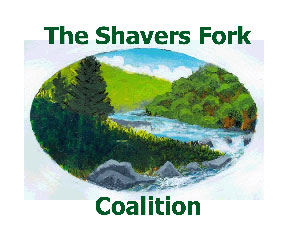Healing the
Headwaters Summit
May
18-19,2000
The
Shavers Fork Coalition, Friends of the Cheat, West Virginia University
Division of Forestry, Canaan Valley Institute, and Mountaineer Chapter
of Trout Unlimited collaborated on a two-day Healing the Headwaters
Summit at Snowshoe Mountain in May of 2000. Representatives from
twenty-five agencies, businesses, educational institutions, and
non-profit organizations attended. A railbus tour of the headwaters
highlighted the first day, during which the group had on-site research
updates on brook trout, stream conditions, and watershed assessments;
news updates on the railroad, Snowshoe resort, and the US Forest
Service; as well as a briefing on the historic site of Spruce.
The
evening and second day were devoted to drafting a document of shared
commitment to the restoration and conservation of the Upper Shavers
Fork. (See document below.) Many of the eighteen signing
organizations, as well as some others, continue to communicate about
and cooperate on Upper Shavers Fork issues, research, developments,
and news.
The document reads as
follows:
A
Shared Commitment for the Restoration and Conservation
of the Upper Shavers Fork of the Cheat River, West Virginia.
The Shavers Fork of the Cheat River is a
quintessential West Virginia watershed. Located in the heart of the
central Appalachian Mountains, the headwaters of the Shavers Fork
originate in Pocahontas County, WV, at nearly 4600 feet elevation.
From these lofty beginnings, the Shavers Fork flows 84 miles to
Parsons, WV, where it joins with the Black Fork River to form the
mighty Cheat River. Historically, the Shavers Fork was truly a
"Wild and Wonderful" place. As late as the early 1900's,
vast stands of Red Spruce covered nearly the entire upper portion of
the watershed and supported a variety of plant and wildlife species.
Associated with these forests was a network of pristine, productive,
cold water streams, which along with the mainstream supported a
diverse community of fish and a brook trout fishery of almost mythical
proportions.
Background:
The once pristine conditions of this area, however, have been severely
altered by a variety of human activities, including acid precipitation
and both the direct impacts and development associated with intensive
logging and coal mining. Contemporary human activities continue to
affect the watershed. Nevertheless, the resilient Shavers Fork
watershed shows promising signs that it is beginning to heal itself,
and there is extraordinary local and regional concern over the future
of the Shavers Fork ecosystem. It is recognized for its potential as a
premier native brook trout fishery and the flagship of the pristine,
high elevation watersheds that once defined the Allegheny Region of
West Virginia.
Purpose:
The partners of this commitment recognize the combined needs of
maintaining an ecologically healthy watershed and developing
sustainable local economies. Towards this end, the purpose of the
"Healing the Headwaters" commitment is: To restore, protect,
and promote the unique natural and cultural resources of the upper
Shavers Fork watershed.
Action Items:
This commitment is based on the principle of partnerships that
encourage and maximize the expertise and participation of local
communities, citizens, non-profit organizations, educational
institutions, government agencies, and the private sector.
The partners have identified, and jointly commit to, the following
action items pertaining to the upper Shavers Fork Watershed.
• Identify the current and historical extent of Red Spruce
coverage and facilitate Red Spruce regeneration.
• Determine the extent of degradation associated with acid
precipitation and mitigate these effects with the best available
technology.
• Identify current sediment inputs to the upper Shavers Fork
and its tributaries and implement approaches to minimize sediment
loading in the watershed.
• Assess the condition of riparian zones
within the area and restore streamside vegetation and upslope
stability in critical areas.
• Assess habitat suitability, develop implementation plans,
and restore native fishes, plants, and wildlife.
• Identify current and potential recreational uses within the
area and develop a comprehensive recreation plan for the future.
• Assess the current transportation system and develop an
ecologically sensitive transportation system.
• Identify and promote the unique history and culture of the
area.
• Promote responsible stewardship of the upper Shavers Fork
watershed and the contribution of the watershed to local economies

![]()